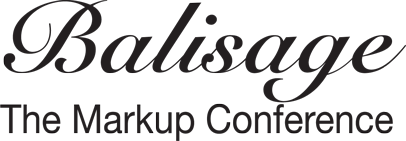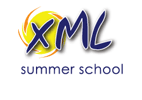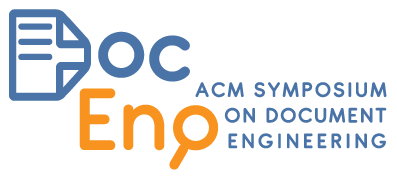Schedule for Thursday
| Time | Room RB211 | Room RB212 |
| 9:00–10:00 | Registration | |
| 10:00–11:30 | Tutorial: Advanced XForms Hands-on: Techniques and Examples | Introduction to CSS for Paged Media |
| 11:30–12:00 | Coffee break | |
| 12:00–13:30 | eXist-db Users Meetup | XSL-FO, CSS and Paged Output |
| 13:30–15:00 | Lunch break | |
| 15:00–16:30 | Schematron Users Meetup | oXygen Users Meetup |
| 16:30–17:00 | Coffee break | |
| 17:00–18:30 | Schematron Users Meetup | oXygen Users Meetup |
How unconference day will be organized
In both morning and afternoon there will be two 1.5 hour long slots separated by coffee break. Sessions will be running in two parallel rooms. Lunch will be provided for attendees with a full-pass.
Program of respective sessions is completely in hands of session organizer. So any queries about particular session should be directed to the session organizer.
Location
The first conference day takes place in the same venue as the main conference. However it is situated in the different building. It is best to use campus entry from the Italská street. You can see entrance and explore area using Google Streetview.
Just use entrance from Italská street and continue straight inside building until you reach atrium. Then use stairs to go one floor up and then look around for rooms RB211 and RB212 (alternatively you can use elevators on the left side and go to the floor marked as 2 on the control panel).
Session details
Tutorial: Advanced XForms Hands-on: Techniques and Examples
organized by Steven Pemberton
XForms is a Turing-complete XML-based declarative programming language for apps both on and off the web.
Following on from the “Introduction to XForms, Hands-On” tutorial at XML Prague’s sister conference, MarkUpUK, this tutorial will cover advanced techniques and methods.
It is advisable to have followed the earlier tutorial (http://cwi.nl/~steven/xforms/xforms-hands-on) before coming to this one.
Techniques covered will include:
- Collapsable sections
- Selection techniques and open selections
- List manipulation, such as keeping lists sorted
- Modifying CSS presentation through XForms values
- Suggestions matching input
- Tabbed interfaces
- Dealing with unknown data structures
- Multilingual interfaces
- Persistence
- The use of SVG
- Time-based presentations
- Dealing with mixed content
As last time, it will be a bring-your-own-device tutorial, and you will be required to install a small piece of software (a server that accepts the PUT method). It will be hands-on, though not as rapid-fire as the previous tutorial, this time with longer presentation sections between exercises.
The materials will also be available for self-study after the conference.
Introduction to CSS for Paged Media
organized by Tony Graham
This tutorial takes an eat-your-own-dog-food approach to showing how to use CSS for paged media. Using the HTML text of its own slides, the tutorial session will progressively reveal and explain the CSS styles that are used to format and paginate the slides. By the end of the session, the fairly undifferentiated mass of text will be formatted with running headers and footers, page numbers and page number cross-references, bleeds, CMYK colours, footnotes, top- and bottom-floats, and other features that appear in paged media but not in a browser.
The session will also describe accessibility features of PDF and include a demonstration of a screen reader recognizing lists in the PDF and avoiding reading the headers and footers on each page.
eXist-db Users Meetup
organized by Juri Leino
eXist-db is an XML database and XQuery engine.
It has been used in small, medium and large applications.
In this community meetup, some eXist-db community members will show new tools and features.
There will be short sessions on:
- eXist-db VSCode plugin
- eXist-db from the command line
- configuring and using Lucene fields and facets
- different methods for request routing
- how to develop packages with build tools and testing
- implementing functions in Java (ixml)
- features and fixes and outlook on version 7
There will be room for questions and discussions.
The session will be interesting for veterans, current and future users of eXist-db.
XSL-FO, CSS and Paged Output
organized by Tony Graham and Alex Critchfield
Producing formatted pages is still important to many of us. The intent of the Antenna House Unconference session will be to again share developments and experiences in producing paged media and to discuss topics of interest.
This 90-minute Unconference Day session will be a session of two halves: we’ll talk with you about the state of Antenna House software, including what’s new with Antenna House Formatter V7.4, and you can talk with us and with your peers about challenges that you’ve faced or features that you’d like to see.
Once again, this is an opportunity to brainstorm with the assembled about a challenge you’re facing and are trying to solve.
If you have an interesting example to share, please get in touch with Tony Graham.
We want this session to address what you are interested in. Give us your comments!
The following are possible topics. The exact makeup will depend on what you, the users, want to see or present:
- Examples of really challenging formatting requirements and how they were handled
- DemoJam – Your interesting formatting examples:
- The challenges
- The final output
- How would you do this with XSL-FO?/How would you do that with CSS?
- Is quality typography important?
- Some really interesting formatting requirement to duplicate historical documents
- The challenge
- Any ideas?
oXygen Users Meetup
organized by George Bina
The oXygen users meetup is a great opportunity to meet oXygen developers as well as other oXygen users. The various sessions we host cover both how oXygen supports you for XML development and XML authoring, presented by our developers and we always try to also invite some of our users to share their experience.
» See more detailed schedule
Schematron Users Meetup
organized by Tony Graham, Andrew Sales, David Maus and Erik Siegel
Schematron is a language for making assertions about the presence or absence of patterns in XML documents. It is widely used as an adjunct or an alternative to grammar-based validation of XML documents using a DTD, W3C XML Schema, or RELAX NG.
If you don’t know Schematron, this session will give you the introduction that you need to understand why other people are using it and why it features in conference presentations. If you already know Schematron, this session will bring you up to date with the current state of the Schematron standard and software as well as show you ways that other people are using Schematron, possibly ways that you haven’t thought of yet.
» More information and ways how to participate












